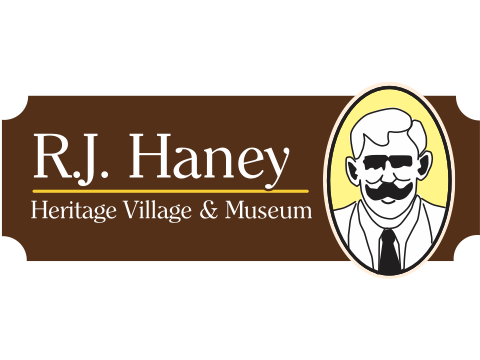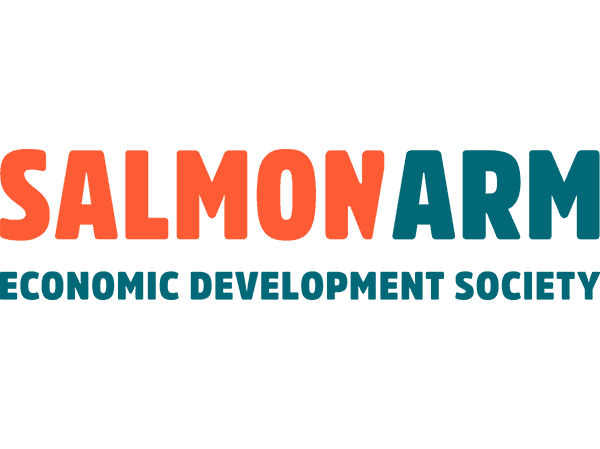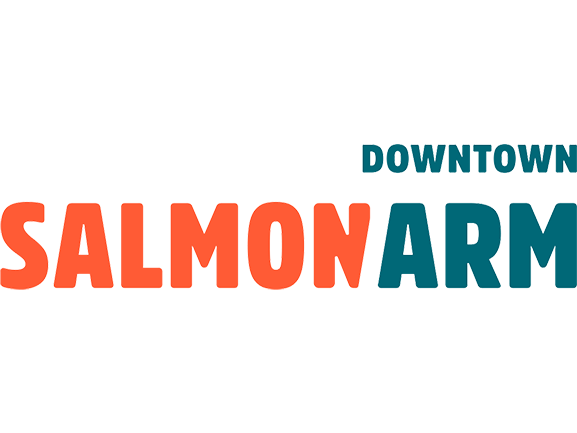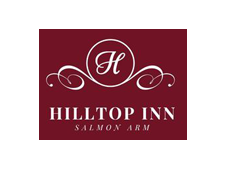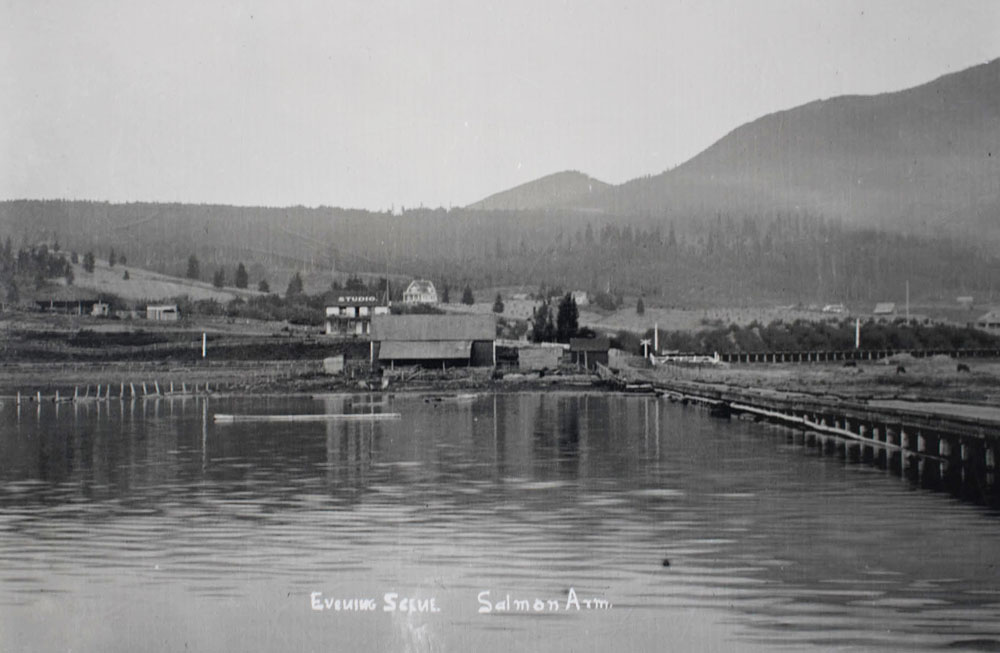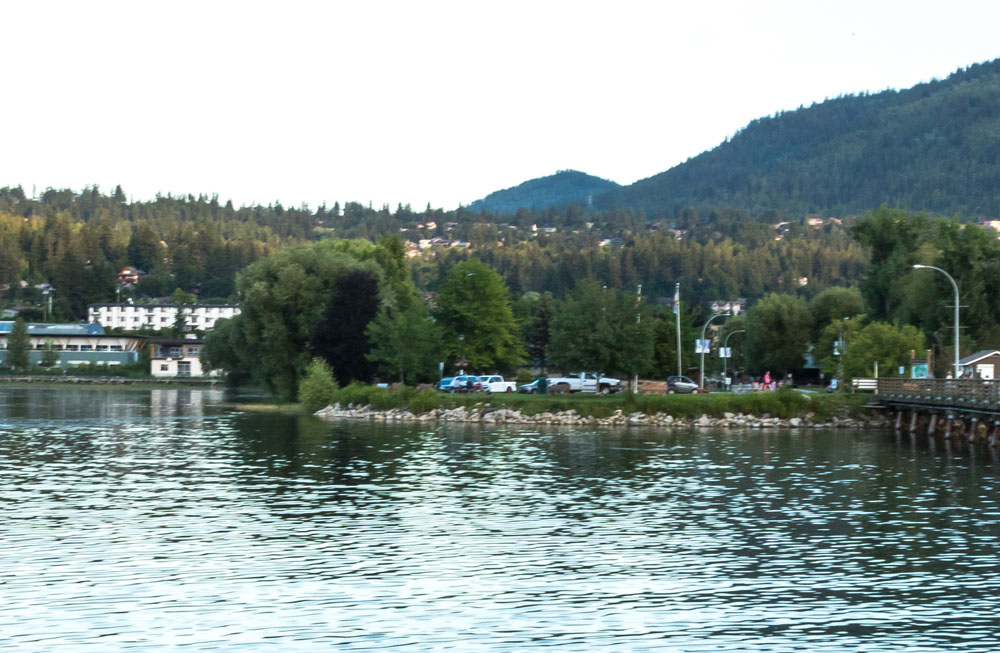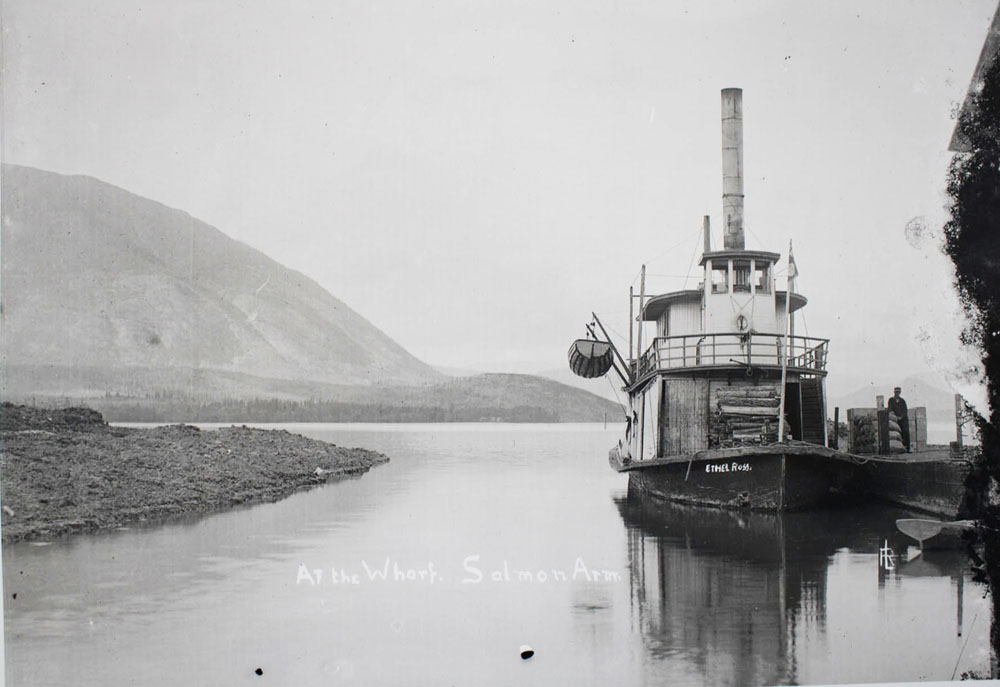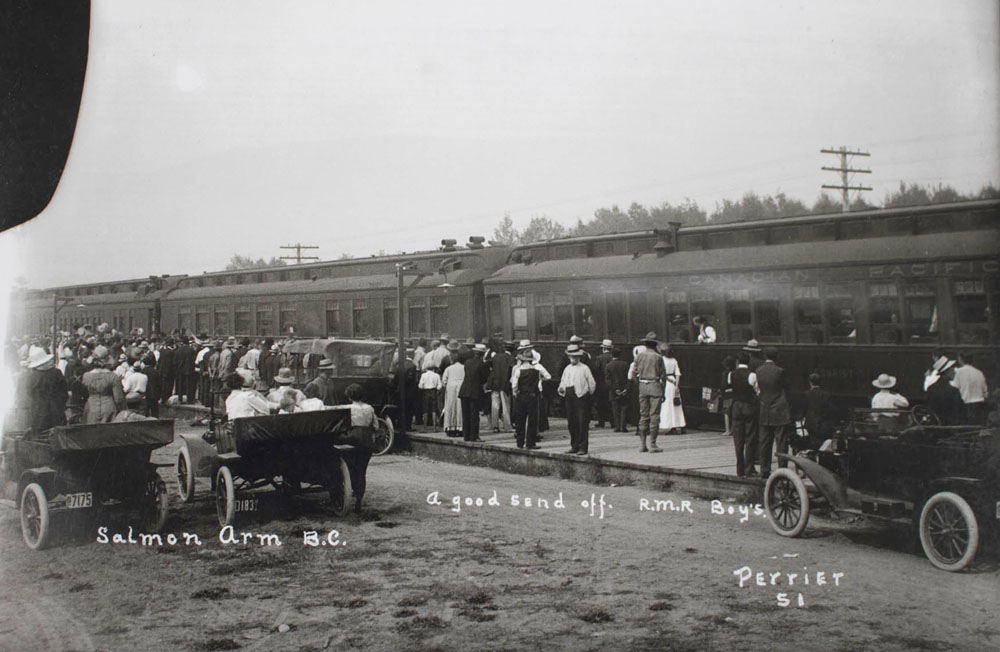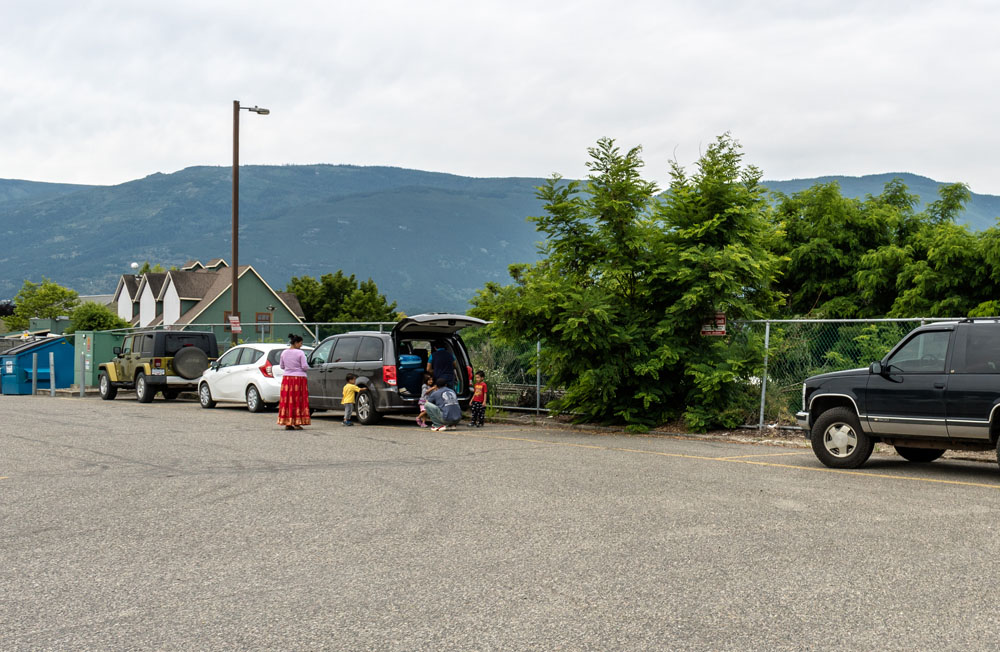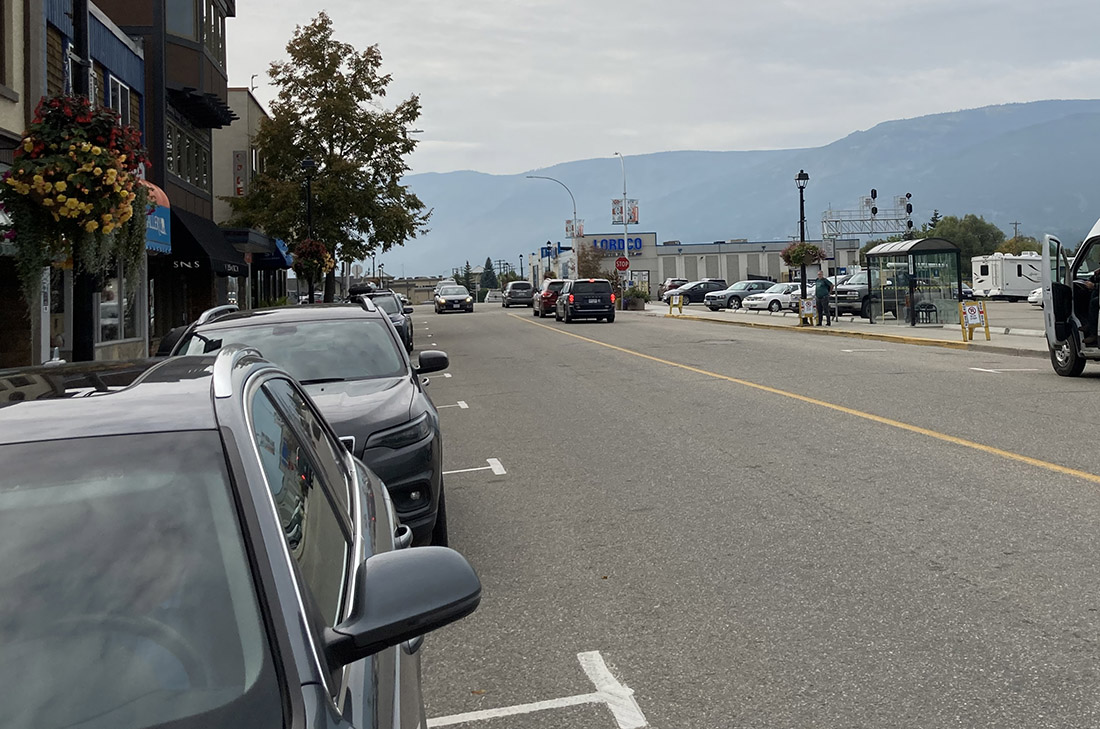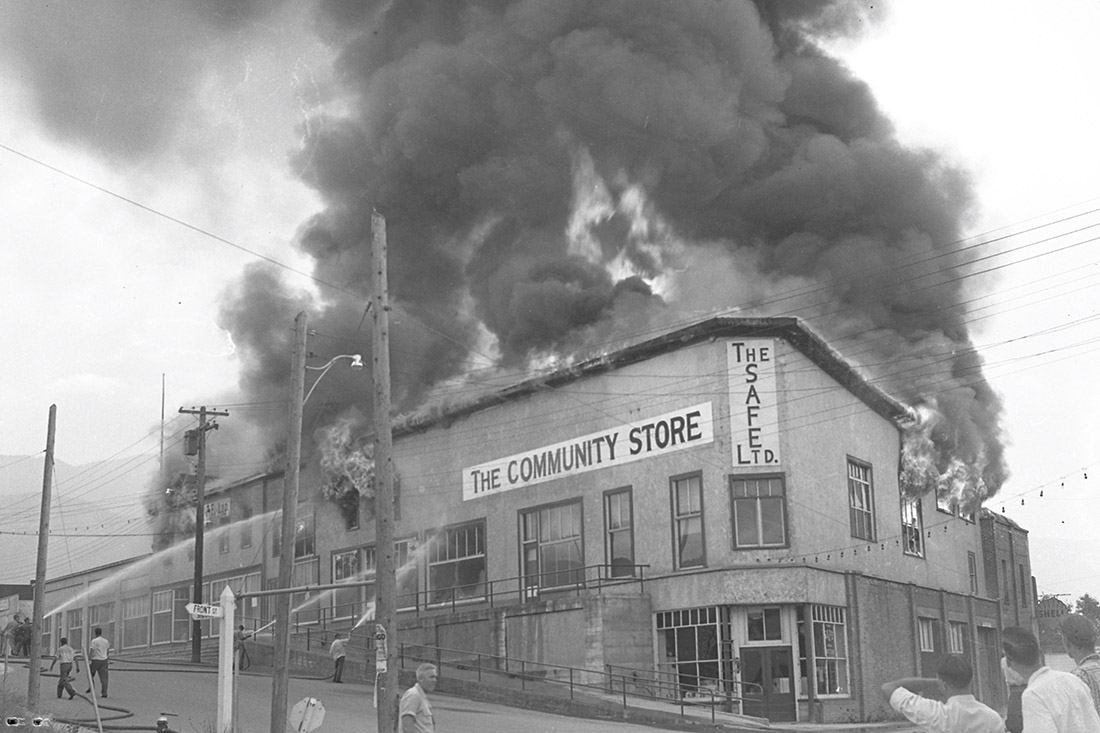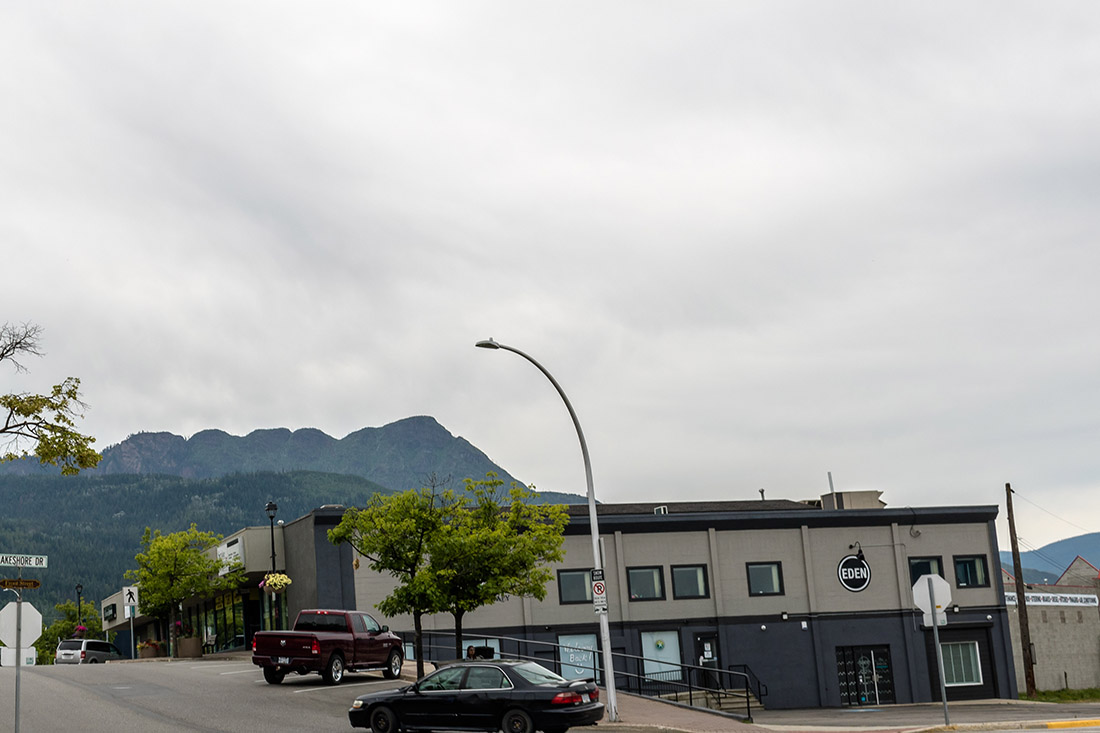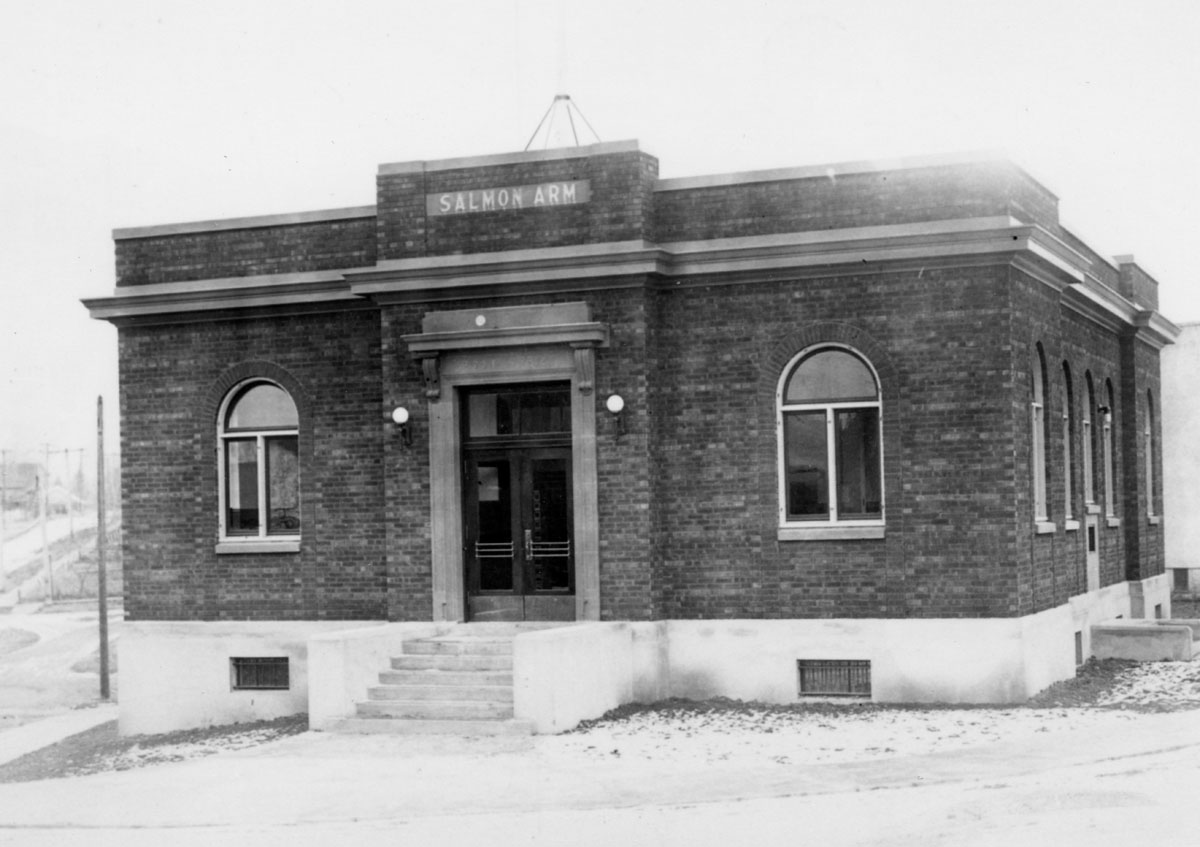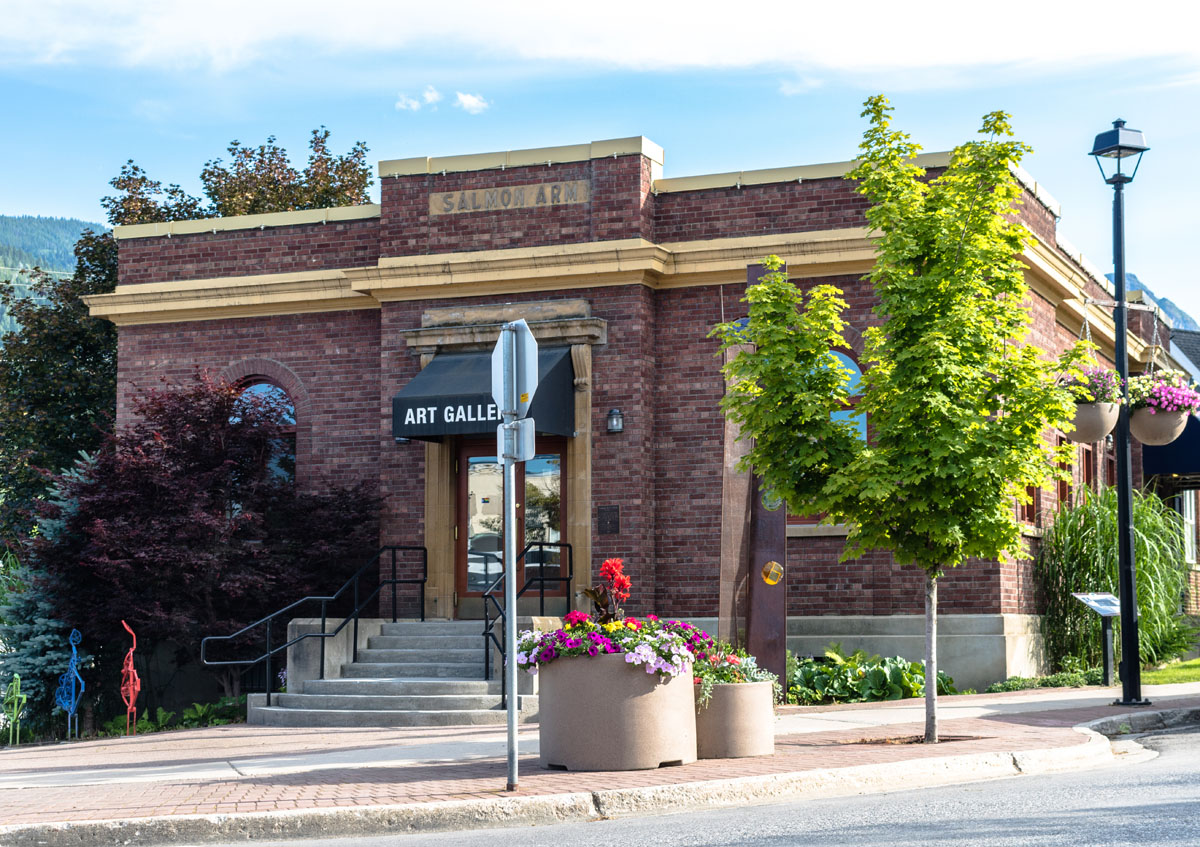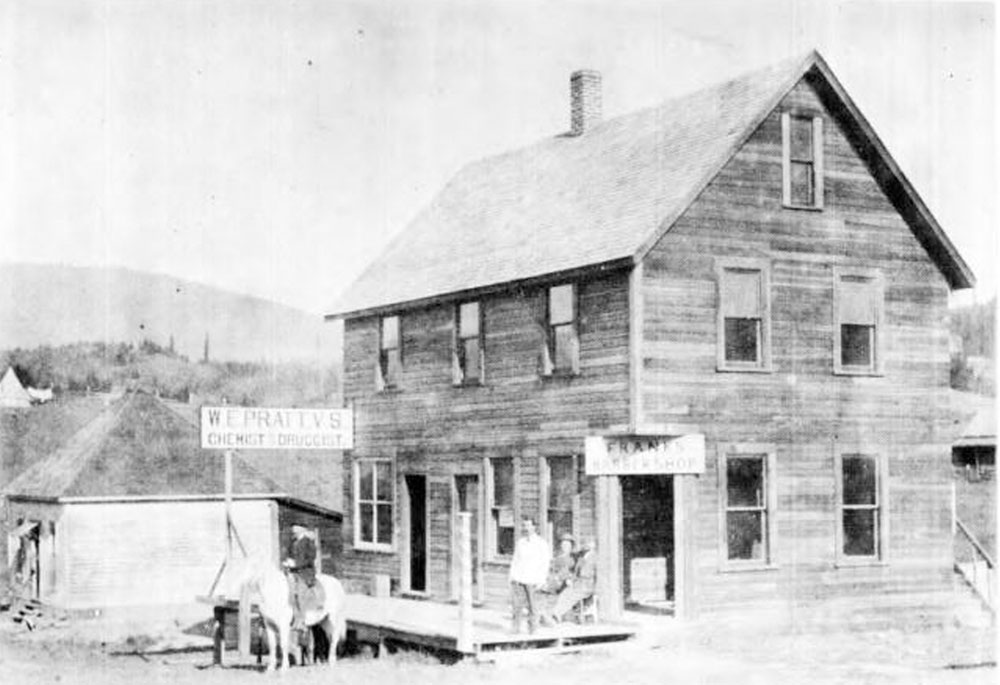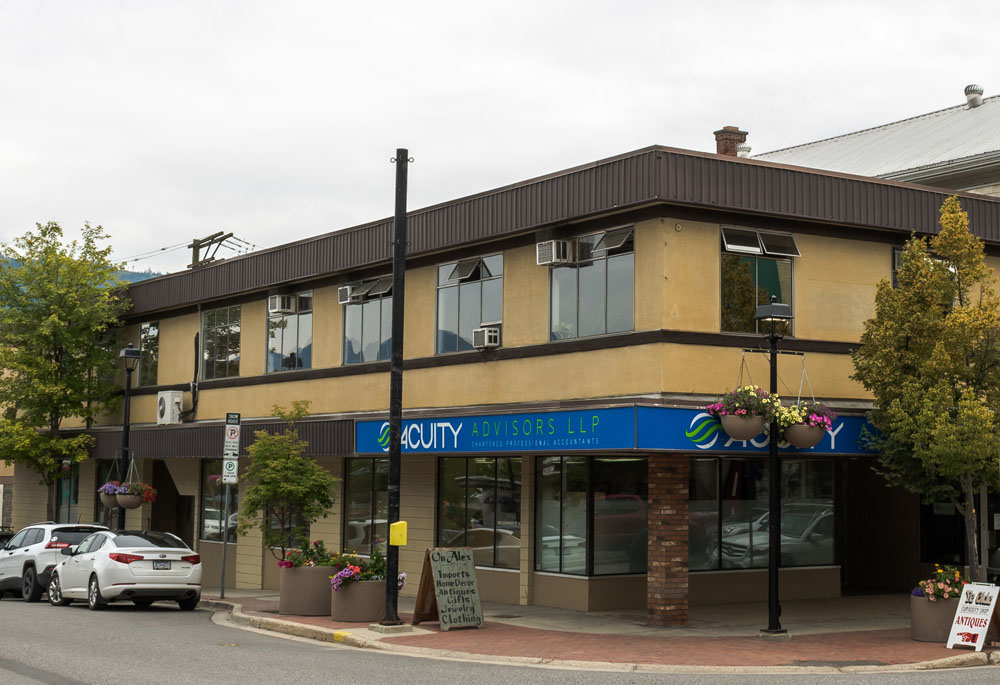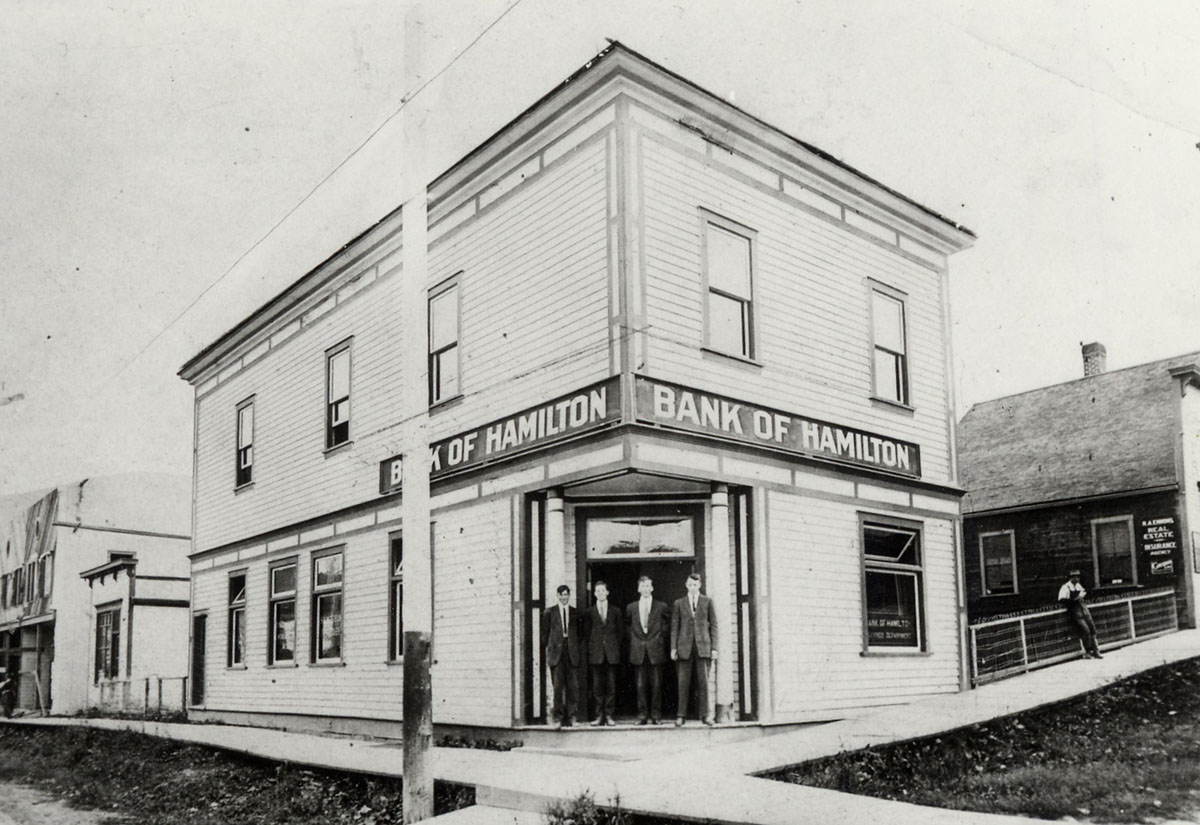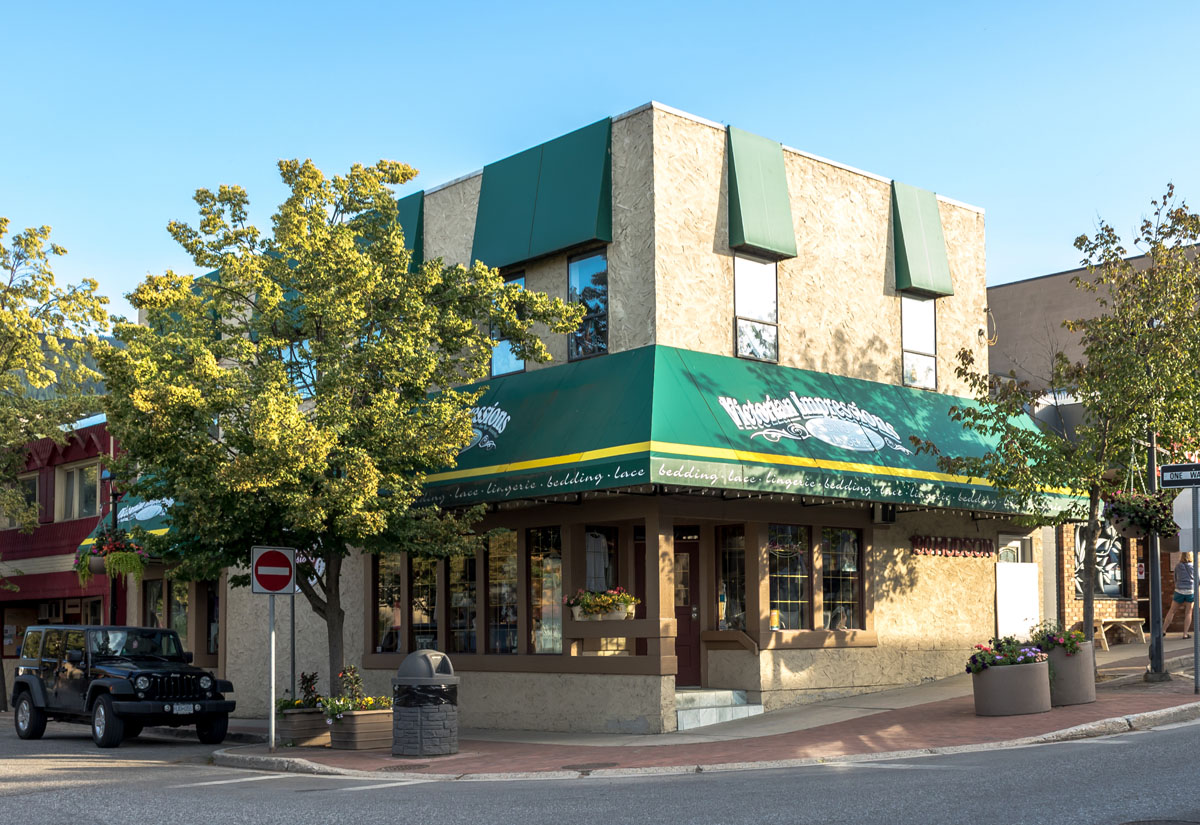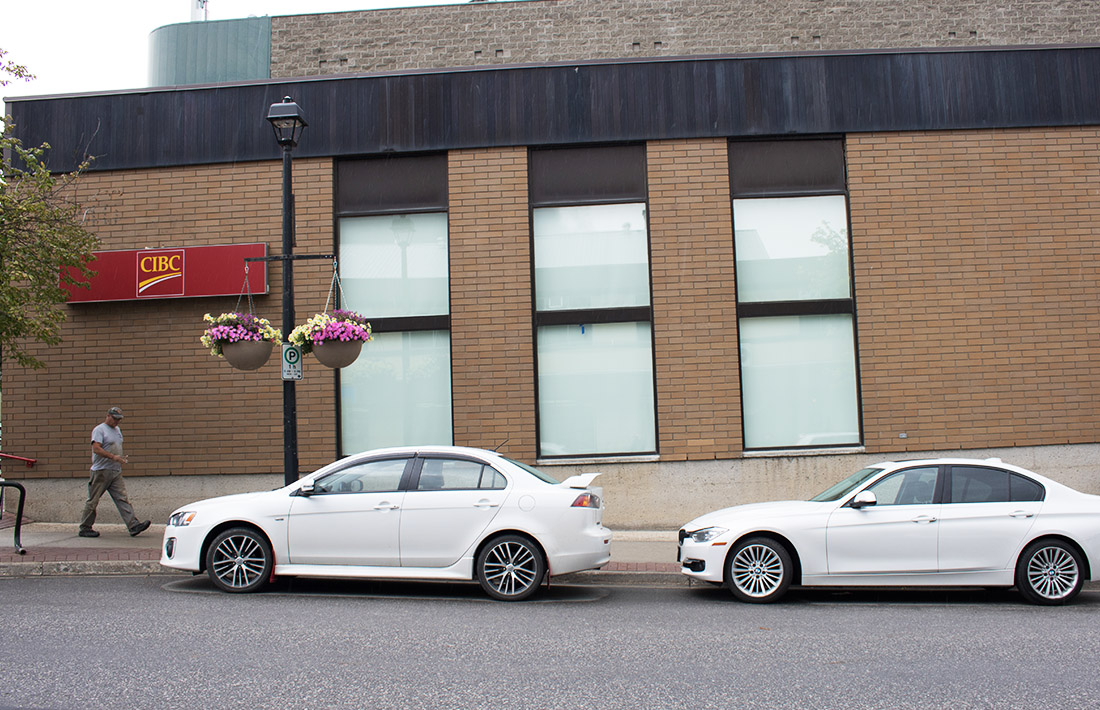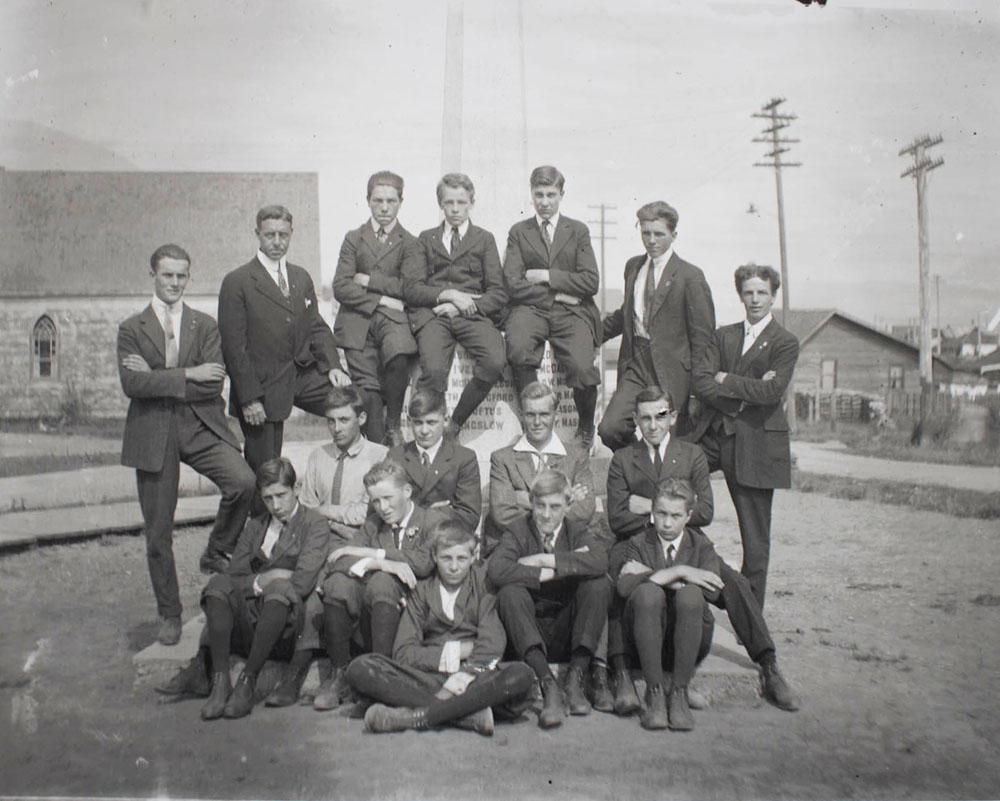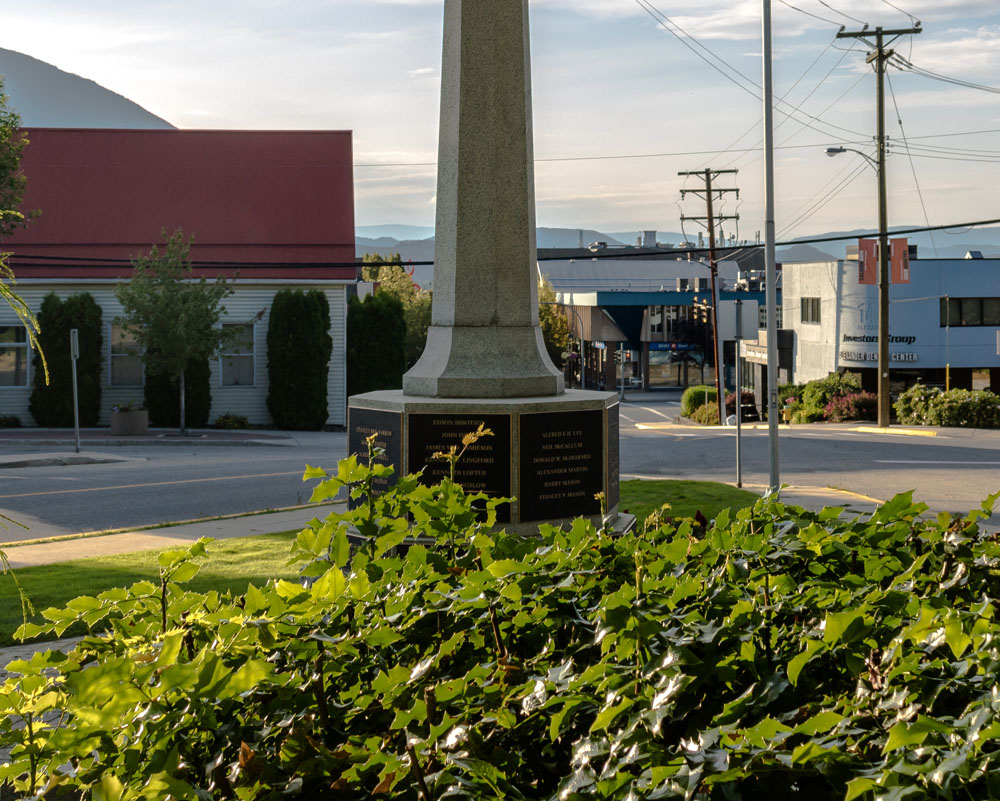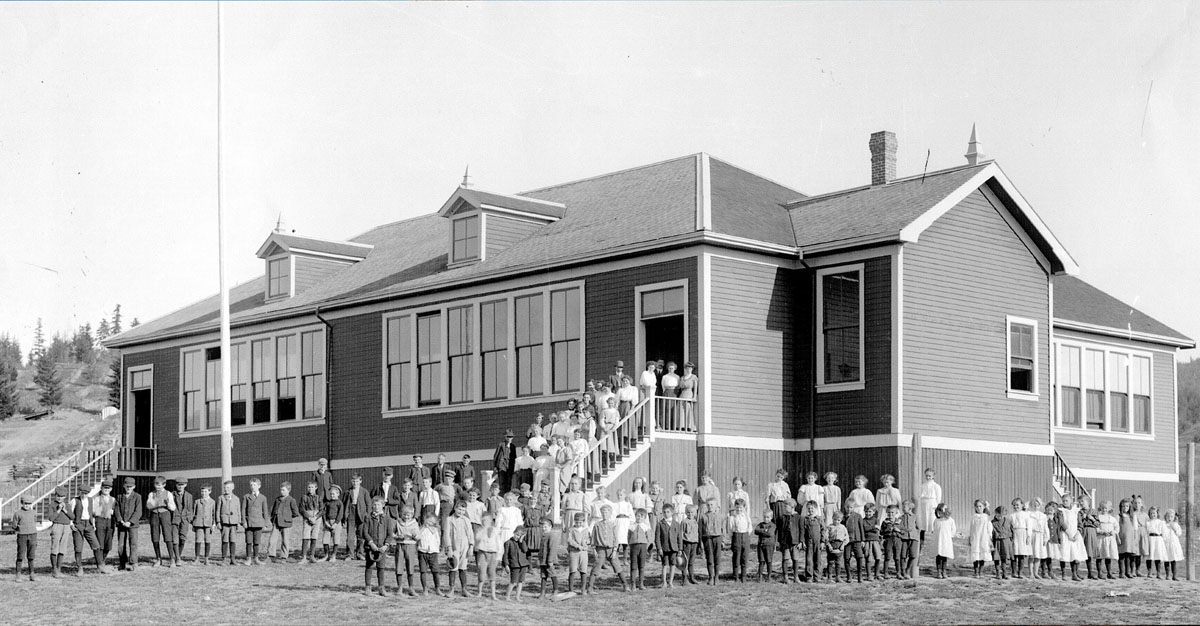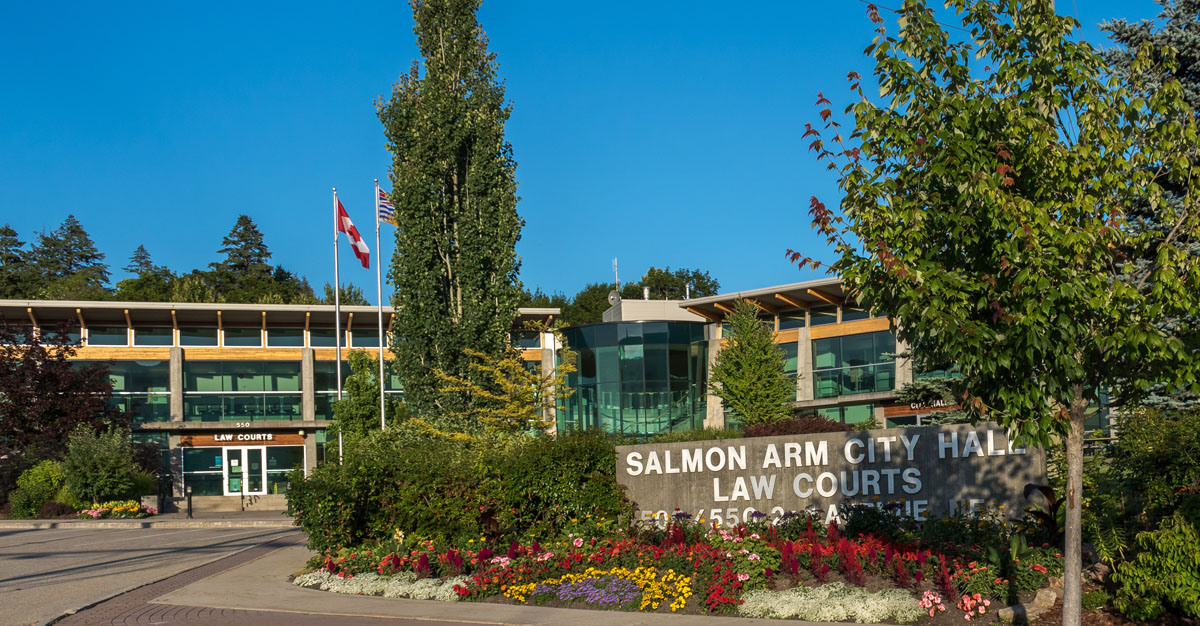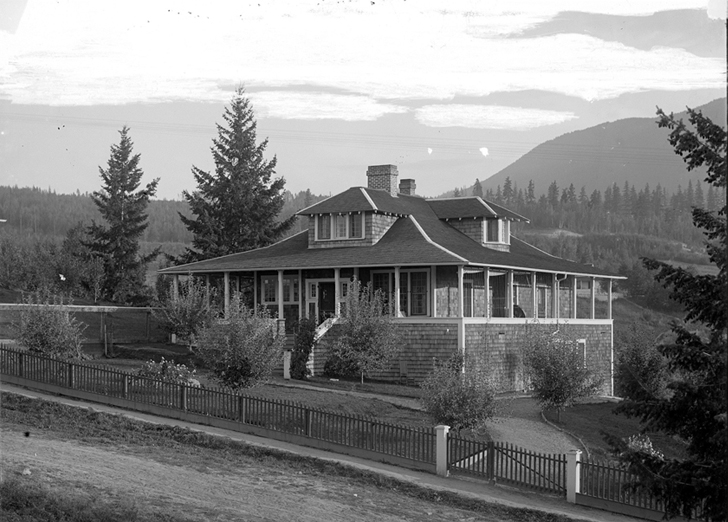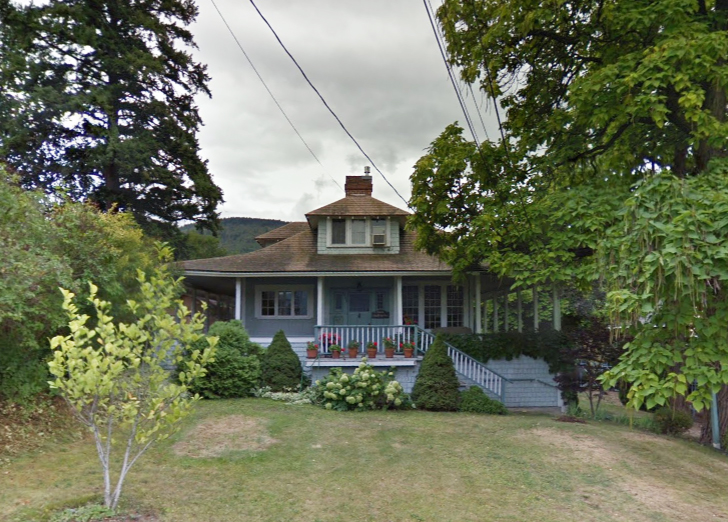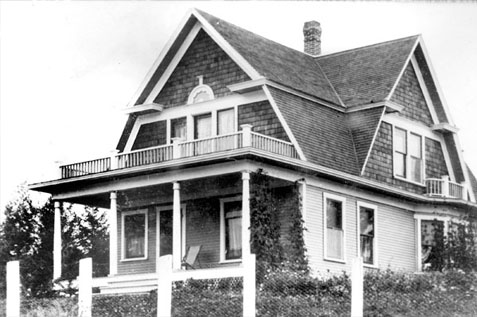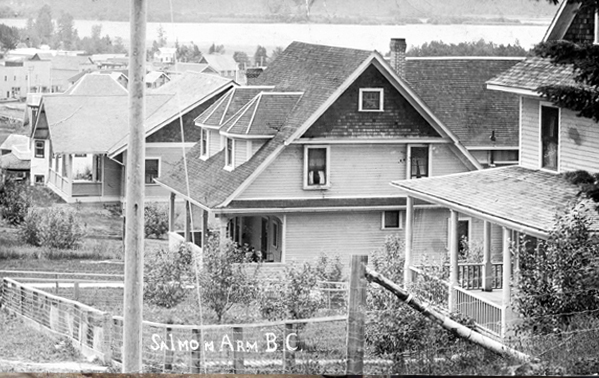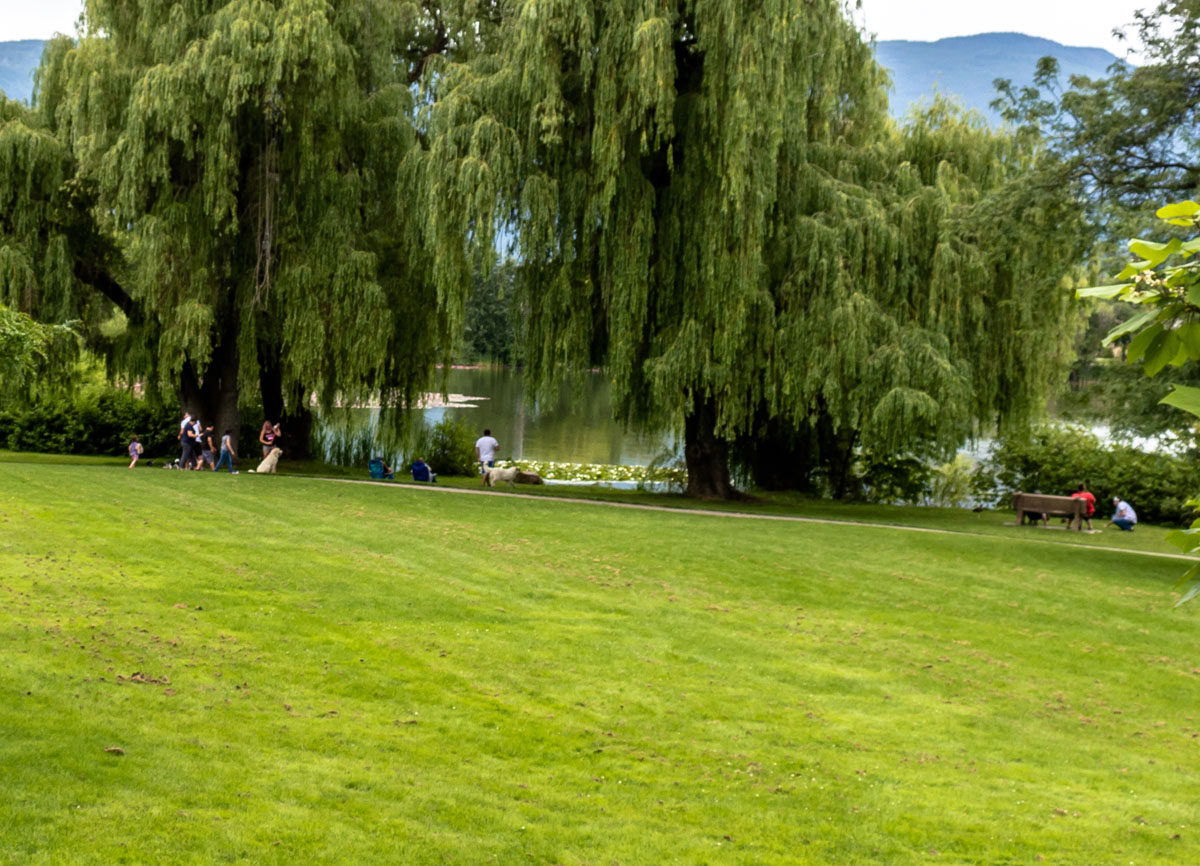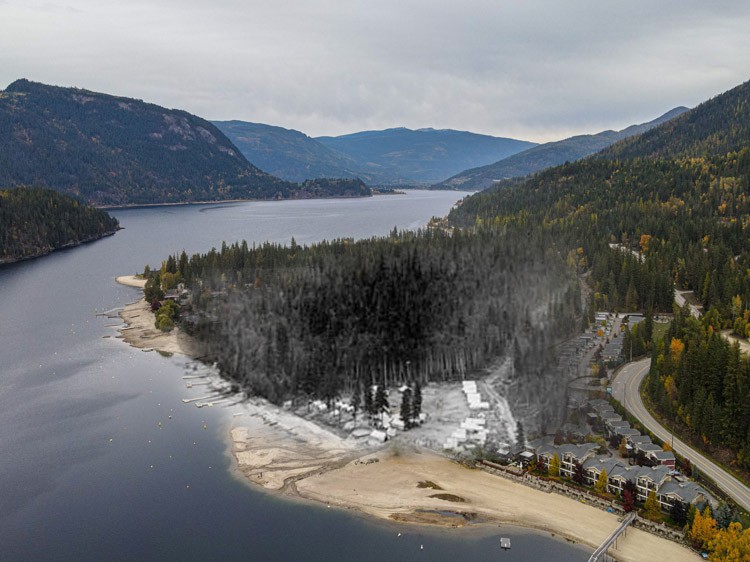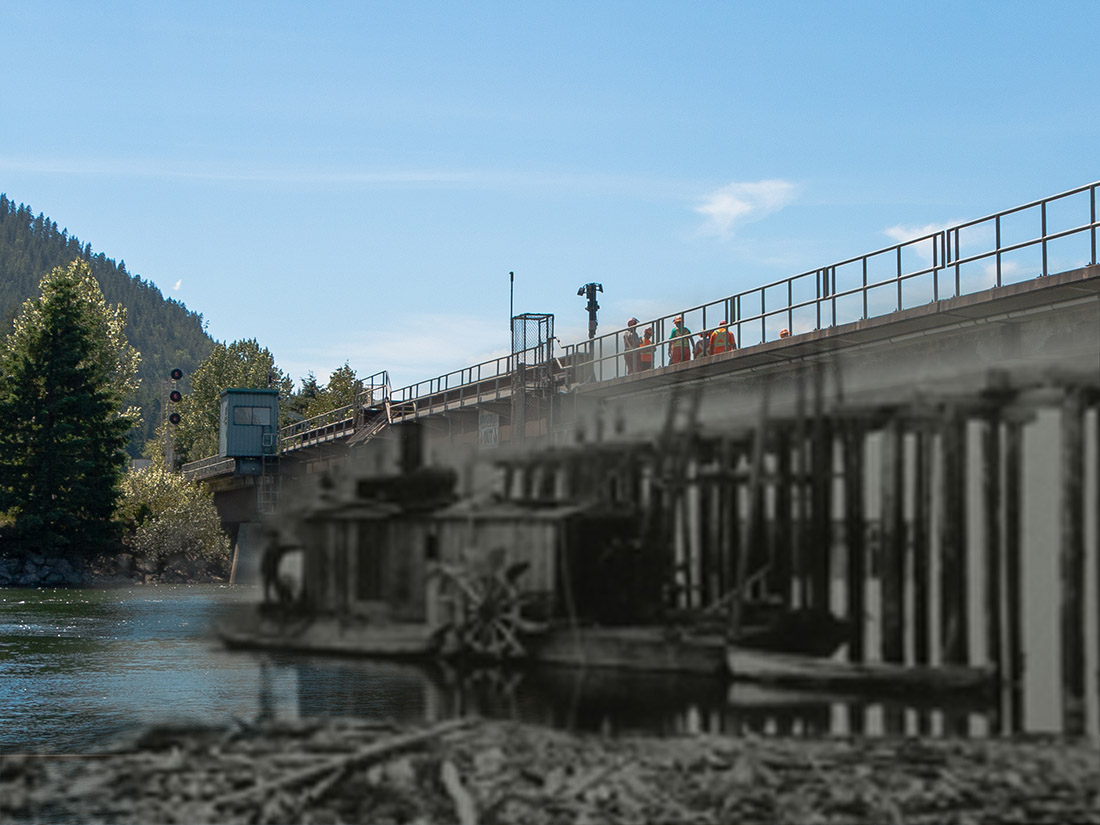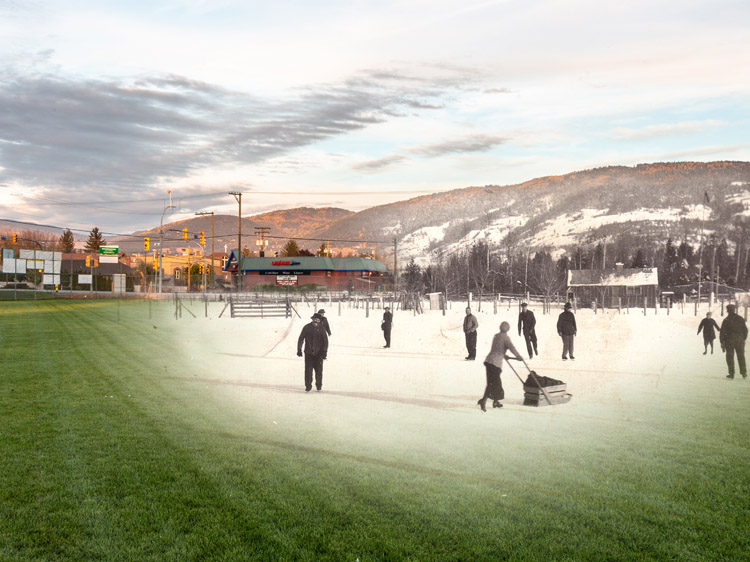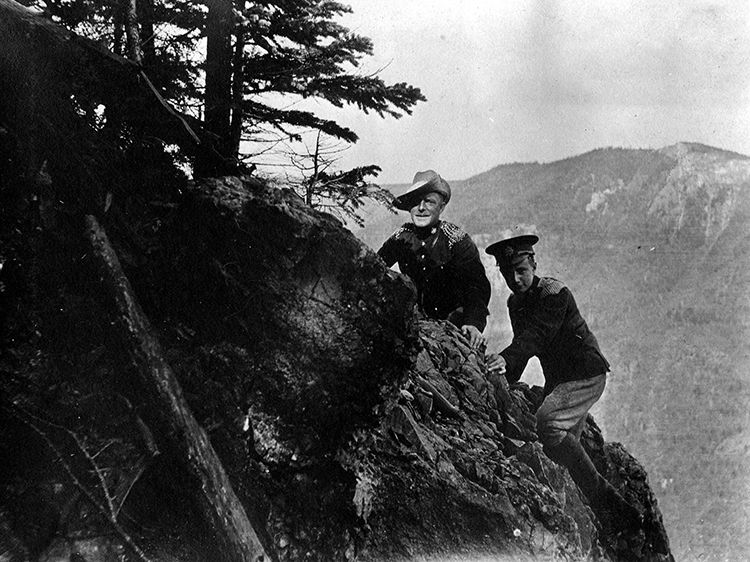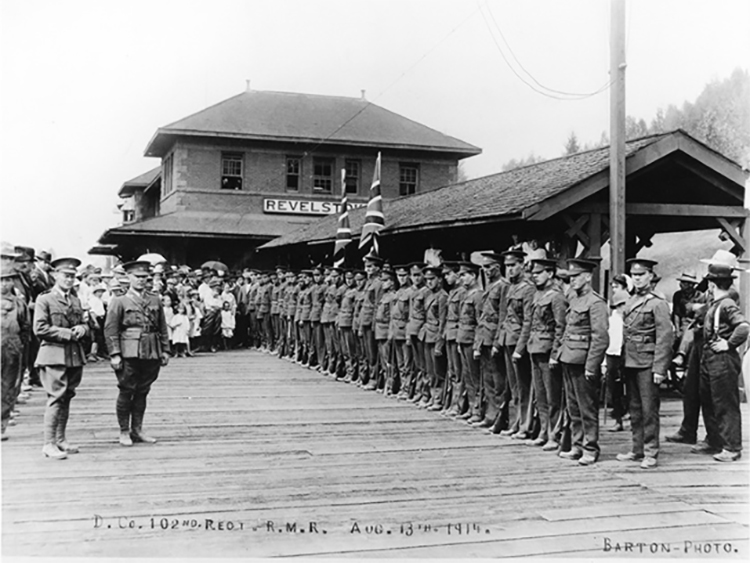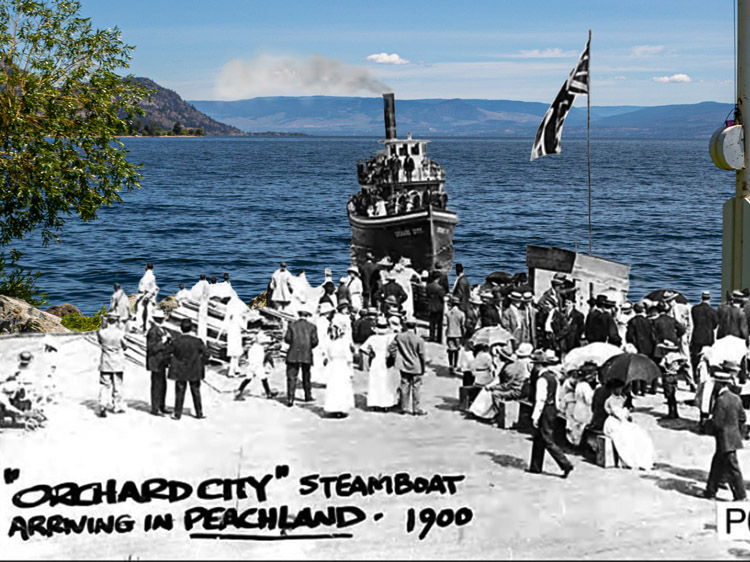Walking Tour
City on the Lake
Salmon Arm's Early History
Alexa Dagan, Deborah Chapman

Archives at R.J. Haney Heritage Village & Museum 1977.0099.0158
Located on scenic Shuswap Lake, Salmon Arm sits nestled in a fertile valley between a set of low mountains. Before Europeans set eyes upon the lake, dense forests framed its shores, rich wildlife drank from its waters, and salmon spawned in the rivers that fed it. Then, much like today, the lake was the heart of the area, and gifted Salmon Arm, and all the surrounding communities, with stunning beauty and innumerable opportunities for recreational activities.
It was the bounty of the lake that fed and cared for the Secwépemc people for thousands of years and provided a waterway for early European explorers in canoes. Later, the area's potential drew the attention of railway executives, who decided to carve a path along the shore of the lake. Settlers followed in the path of the railway.
Salmon Arm has continued to be noticed for its natural beauty and bounty, and the city has supported a small community of driven, caring individuals who always pull together in times of hardship. From multiple fires, floods, bad winters, and wars, this small city knows the power of community and understands the value of one's neighbours.
The tour begins on the long wharf at Salmon Arm's waterfront, and briefly summarizes the history of the Secwépemc First Nations, and their relationship with the Shuswap. As we head towards downtown, we make another brief stop on the shores of the lake to explore the stern and side wheelers that moved people and goods around the Shuswap. Continuing on the theme of transportation, we turn onto Lakeshore Drive NE, for a stop at the historic C.P.R. station, before walking along Lakeshore Drive to learn about the community's farming roots, and the growth of the town.
Next, we turn left onto Shuswap Street and left again onto Hudson Avenue where we learn more about the town's postal system, and view the historic trio of Ggovernment buildings. As we walk along Hudson, we uncover the alarming nature of medicine during Edwardian times. From there, we cross the street to view the Montebello Hotel disappear behind a wall of flame.
Turning right on Alexander Street, we cross the Trans-Canada Highway to stop at the Cenotaph and reflect on the lives Salmon Arm lost in World War I and IIthe First and Second World Wars , and the Korean War. Backtracking slightly, we head onto 2nd Avenue NE where the site's first school once stood. Continuing along 2nd Avenue (Harris Street), we take a walk through Salmon Arm's original upscale neighbourhood for a peek at some of its oldest homes. Finally, we end the tour at McGuire Lake, where we come back to the downtown area. Here we learn more about Salmon Arm's settlers, and view the natural beauty of the town's setting.
Before we begin we'd like to acknowledge that we are on the traditional territory of the Secwépemc First Nation. We honour their Elders and knowledge keepers, past and present and we pay our respects to those who have been custodians of these lands since time immemorial.
This project is a collaboration with the Salmon Arm Heritage Commission, the R.J. Haney Heritage Village & Museum, the Salmon Arm Economic Development Society, and the Downtown Salmon Arm Improvement Association. We also owe thanks to the support of the Hilltop Inn.
1. Abundant Shuswap
Archives at R.J. Haney Heritage Village & Museum 1983.0014.0112
1909-1910
This early photo of Salmon Arm looks towards the fledgling community basking in the evening sun. Taken by Rex Lingford between 1911 - 1913, the photographer's studio features prominently in the photo, while a number of farms dot the landscape leading up to the mountains. Today, trees block the majority of the city from view.
Salmon Arm, one of four arms of the Shuswap, was named for the bountiful runs of salmon that once swelled the waters of tributaries feeding the lake. According to settlers, "Many of the Old Timers can remember years when salmon could . . . be pulled out of the creeks by a pitchfork. Salmon were gathered. . . and used as fertilizer. Indeed, coyotes during the winter would dig up and eat the highly odoriferous fish."1
* * *
The name Shuswap is an anglicized version of Secwépemc, after the First Nations people on whose traditional territory Salmon Arm is built. The Secwépemc are the most northern of the Interior Salish people, composed of 17 bands whose traditional land spans a vast range of approximately 180 thousand square kilometres, including the cities of Kamloops, Williams Lake, and Revelstoke. The Shuswap Nation Tribal Council represents all 17 Secwépemc bands including the reserves around Chase, Enderby, and Salmon Arm.
The Secwépemc lived a semi-nomadic lifestyle, travelling for sustenance and trade throughout the summer, and living in circular pit-houses, or Kekulis, during the cold season. According to Ernest Doe, author of Centennial History of Salmon Arm, there was a small community that lived on the high ridges between Sandy Point and the mouth of the Salmon River in 1882.2
The arrival of Europeans changed things dramatically for the Secwépemc people. The first devastating blow came in the form of the province-wide smallpox outbreak beginning in 1862. The Secwépemc, who numbered between seven and nine thousand before the epidemic, lost as many as a third of their number to disease.3
Shortly before the outbreak, B.C. Governor James Douglas negotiated with Secwépemc Chief Neskonlith to divide the land in order to facilitate European settlement. The bands, led by Neskonlith, completed the negotiations with large reserve lands spanning 3,569 square kilometres, enough to support the needs of the community.4
However, with entire villages annihilated by the smallpox virus, Douglas' successor, Joseph Trutch, who was outspoken in his extreme disdain for First Nations people, claimed the Secwépemc were not making use of reserve land. Only a few years after the reserve lands were established, Trutch stripped thousands of square kilometres from the Secwépemc without their consultation or consent, much as he had done to other First Nations across the province.
The Secwépemc, having lost band members to disease and land to the colonial administration, soon faced a whole new horror which was the Kamloops Residential School. Established in 1890, the school's primary purpose was to Christianize, and assimilate Secwépemc children into the official settler-colonial culture. Children were forcibly taken from their families, forbidden to speak their language or practice their culture, and spent years ashamed of their way of life. The Kamloops Residential School closed in 1977, but the scars remain.
Today, Secwépemc Elders work tirelessly to educate others about their culture, preserve their language and heritage, and to fight for their land. Well-known Elder, Dr. Mary Thomas, laid the groundwork in preserving and recognizing the value of the Secwépemc culture. Her son, Neskonlith Councillor Louis Thomas carries on her work. Having attended the Kamloops Residential School himself, Louis now works to raise awareness about Secwépemc culture, and to share stories. In 2020, Louis was awarded a B.C. Medal of Good Citizenship, which celebrates those who demonstrate exceptional commitment and service to their communities.
2. On The Shores
Archives at R.J. Haney Heritage Village & Museum 1983.0014.0120
1909-1914
In this photo, the S.S. Ethel Ross, a sternwheeler steamship, is docked in the dredged channel at the Salmon Arm waterfront. Built in 1887, this ship was no longer a maiden when Rex Lingford snapped this photo between 1909 and 1914. The S.S. Ethel Ross was one of several sternwheelers that travelled the waters between Savona, the North Thompson River, the Shuswap communities, and Enderby, before the region became crisscrossed by roads.
* * *
Between 1866 and 1916, side and stern wheelers reigned as the primary form of transportation in the Thompson/Shuswap area. A total of 19 ships served the region to fulfill every transportation need, such as hauling supplies and men to the goldfields, supplying building materials and labourers for the railway, providing shipping for settlers, and servicing the logging industry. While the ships were necessary, they were not always reliable. They made frequent stops for pick-ups and deliveries, and to load cordwood for fuel.1 Sternwheelers could become lodged on sandbars in low water and the Captain would order the cordwood pitched overboard to refloat the vessel.
Before the government wharf was built, which is today the longest curved wooden, freshwater wharf in North America, steamships had to carefully seek out a path to shore through the expansive mud flats, or use gangplanks to get people and supplies to solid ground. Early surveyor George Mercer Dawson describes his own frustrations with the mud-fraught shoreline around Salmon Arm: "we were grounded on the mudflats a quarter of a mile from the Salmon Arm station. Took off boots, and wallowed to shore and back through about a hundred yards of soft mud – so soft in places as to evoke fear [of] being engulfed altogether. To the station and telegraphed for mail to be sent to Sicamous tomorrow. Then to McGuire's store and got a fresh supply of provisions of which we seem likely to be short."2
By 1913, the steamships, so vital to communities in the late 19th and early 20th centuries, had become expensive and inconvenient. At the beginning of World War I, steamships had ceased to operate except for cruises on the C.R. Lamb. The Lamb's last owner was the first Canadian-born, ethnically-Chinese Eengineer, Wm Louie, who secured the mail contract for Shuswap Lake. The Lamb was the last of the region’s sternwheelers when she was beached in 1948.
While the steamships reached the end of their era, the Shuswap Lake remained vital to Salmon Arm. Another passage by George Mercer Dawson remarked that the valley bottom held promise. "Skirted around the great bay into which the Salmon River flows, and which is low and swampy along shore everywhere, but may, with the lower part of the Salmon River Valley, which seems quite flat, contain a considerable area of land eventually arable, now thickly timbered. If cleared would need no irrigation."3
3. They Came with the Railroad
Archives at R.J. Haney Heritage Village & Museum 1980.0003.0031
1914
Titled "A good send off of R.M.R. boys," this photo captures a large crowd and several automobiles gathered around a train car full of young men departing for the First World War. The Rocky Mountain Rangers were deployed first for local protection duties as the 102nd Regiment on August 6th, 1914, just two days after Canada entered the war. These men would not, as many expected, be home by Christmas.1
One of the duties of the R.M.R. at home was to staff enemy alien internment camps at Revelstoke, Mara Lake, and Vernon. Meanwhile, a local militia guarded the railway, as maintaining the transportation routes was essential to the security of the nation
* * *
4. Getting to and from Town
Archives at R.J. Haney Heritage Village & Museum 1980.0002.0011
ca. 1910s
This block, which now hosts the Salmar Classic Theatre and several retail storefronts, was once dominated by the Canadian Imperial Bank of Commerce and the gorgeous Montebello Hotel. Although the C.I.B.C. is still located on this street, it was only constructed on the corner lot after the Montebello Hotel fire of 1967. The Montebello Hotel was built in 1908 and became the social focus of the small farming community. You can see a lone Ford Model T parked on Alexander Street outside the Montebello, showing the community’s changing relationship with transportation.
* * *
While more roads were built in and around the surrounding community in the late 19th and early 20th centuries, they were still largely used by horse drawn wagons and carts. Wagon drivers faced shin deep mud, puddles, and piles of horse manure on their way around town, a situation only complicated when automobiles came to Salmon Arm. The speedy new vehicles came into conflict with the slower, less maneuverable wagons often enough that the Salmon Arm Observer published a courtesy rule for automobiles in 1927, "Drivers of horses have asked that auto drivers use their horns when approaching horse-drawn vehicles from the rear."1
There was another factor that contributed to confusion on the roads. Prior to 1920, driving was a free for all in the B.C. Interior. Vehicle drivers travelled and parked on whatever side of the road they liked, with right-hand and left-hand drive vehicles co-existing with pedestrians and wagons. This was enough of an issue that as far back as 1892, John A. Mara, MP for Yale Riding, suggested B.C. implement a Rule of the Road. He recommended that the government decide between driving on the left or on the right.2 Once the right hand drive rule was established, there was difficulty in some areas convincing drivers to follow it. To remind drivers to keep right, a device known as a "Silent Policeman" was installed at the corner of Alexander and Front Street. (now Lakeshore Drive N.E.). Cutting across the intersection, their vehicle made contact with the Silent Policeman, alerting the driver "with a wonderful clang."3
5. Salmon Arm Farmers' Exchange
ca. 1940s
A parade passes the Salmon Arm Farmers' Exchange, the collection of buildings across the street. The Salmon Arm Farmers' Exchange began as a small, fruit-shipping co-operative in 1907. Over time it grew into a large organization whose operations included fruit packing, cold storage, retail flour and feed, hardware and building supplies, a sawmill, a wholesale lumber department, and shipping vegetables. The 'Exchange helped create another organization, S.A.F.E. Ltd, so it could remain focused on exporting apples, while S.A.F.E. Ltd , across the street, focused on retail. The 'Exchange was such a successful enterprise, it soon became known as "the greatest farmers' commercial organization in this city"1 but the fruit industry took years to mature.
* * *
Business was booming, and the 'Exchange suddenly faced a shortage of space. A new facility was built, with a concrete basement floor, insulated walls and ceiling, and an elevator. During the height of apple production, fruit from Salmon Arm shipped to Northern Ireland, the West Indies, the Middle East, and South America. While Salmon Arm's apple empire seemed assured, it was not to last. When the 'Exchange building burned in 1975, it was the end of an era. Fruit growing in the Shuswap had been on the decline for a quarter of a century. One particularly brutal winter in January 1950, coupled with unusually warm and sunny days in February, decimated fruit orchards. The Salmon Arm Farmers' Exchange was sold in 1959. The heyday of Salmon Arm's fruit production was over and, while some orchards still remain, local agriculture has moved on to dairy and mixed farming.
6. S.A.F.E. Burns Down
Archives at R.J. Haney Heritage Village & Museum 1995.0042.0004
1956
On August 25th, 1956, the S.A.F.E Limited complex caught fire, and burned to its foundations. The staff and the Board of Directors, who happened to be on site at the time for a meeting, were hastily evacuated and stood by watching their business burn. The minutes from the meeting, which continued the next day, failed to capture the gravity of the loss, "Meeting interrupted by fire: entire building burned down. Some records saved."1 At the time of the fire, S.A.F.E Limited consisted of grocery, hardware, and dry goods departments, with a menswear section, a meat department, and freight elevator.
* * *
Formed as a wholesale cooperative, the 'Exchange had begun selling retail supplies like flour to its members. This upset local merchants, who did not have the 'Exchange's advantage of cheaper shipping rates nor the luxury of buying wholesale. Up in arms, the merchants delivered a petition to the railway company. Retail sales were in violation of the lease the 'Exchange held with the C.P.R. The railway company acted quickly with an eviction notice. It was this final action that led to the separation of the retail and shipping activities, the creation of a separate co-operative, S.A.F.E. Ltd, and the success of both businesses.
7. The Postal Service
Archives at R.J. Haney Heritage Village & Museum 2012.0010.0010
1937
This building, now the Salmon Arm Arts Centre, was originally the community's post office. A classic brick building with a parapet and cornices, the post office was designed by renowned Canadian architect Thomas W. Fuller. Designated the Chief Dominion Architect from 1927 to 1936, Fuller's portfolio included several federal buildings in Dawson City, Yukon that are now National Historic Sites, as well as the Confederation Building in Ottawa. The post office became the community's public library in 1974, which it remained for twenty years before it became the Salmon Arm Arts Centre.
* * *
The first post office in the community operated out of a family home, but was soon relocated to McGuire's General Store, where Charles McGuire was both merchant and Postmaster. As the community grew, the post office moved to a location on Front Street (Lakeshore Avenue), and rural mail was delivered using horse and buggy.
By 1930 a larger facility was needed! Although the contract was awarded in 1935 for the Thomas Fuller design, the project was plagued by delays. Two years later, the post office finally opened without pomp or circumstance, ready to serve the community. An addition was built in 1948 and the building was decommissioned in 1974.
The corner of Shuswap and Hudson included the courthouse, post office, and municipal offices. As a unit, they represented Salmon Arm's growing importance as a civic centre for the surrounding community.
8. Community Health
Archives at R.J. Haney Heritage Village & Museum 1967.0141.0000
1912
Two businesses operated out of this building on the southeast corner of Hudson and Alexander: Dr. W.E. Pratt’s clinic, and Frank Robicheau’s Barbershop. In this photo, Dr. Pratt sits atop his horse, while Robicheau stands a few feet away in a white jacket. In addition to being the town's chemist and druggist, Dr. Pratt was also the community veterinary surgeon. While today, we would not obtain a medical prescription from the same person who performs surgery on our horse, in the late 19th and early 20th centuries it was common to have a professional who could do both. In addition to housing a barber and pharmacy, the town band also practiced in the building.
* * *
In its lifetime, the building fulfilled many other purposes, becoming a doctor's office, a meat market, and even a flower shop. The town doctor, A.K. Connolly established an office in the former stationery shop in 1912. Six years later, Dr. Pratt passed away in hospital after being admitted for appendicitis. By 1920, doctors were quite familiar with appendicitis, and had been successfully performing appendectomies under anaesthesia since the 1880s. It is unclear whether 64 year old Pratt died from the ailment, or complications from surgery. Regardless of how he died, Dr. Pratt must have made a positive impression in Salmon Arm. Even six years after his departure, the Salmon Arm Observer still published his obituary, noting that his death would be a blow to many of the town's "Old Timers."1
Despite Dr. Pratt and his wife leaving Salmon Arm, it appears that his family retained some ties to Salmon Arm. His son, H. H. Pratt, lived with his wife in nearby Sorrento when their son was born in 1921, while his brother, Ernest and his wife, purchased a house on Harris Street in 1947.
9. Mah Yick's Laundry
Archives at R.J. Haney Heritage Village & Museum 1979.0123.0001
1912
The Bank of Hamilton was built in 1910 and quickly became a landmark. It was prominently placed on the south east corner of Hudson and Alexander and attracted a large and loyal customer base. It helped that it was the first bank to open its doors in Salmon Arm.
In 1911 Mah Yick moved his laundry from “China town” several blocks west of town to a vacant building next door to the bank. The unpainted building to the right is where Mah Yick set up shop. Imagine the stir he caused . . .
Not speaking a word of English, it must have taken a great deal of courage for Mah Yick to immigrate to Canada from China. Anti-Asian sentiment was prevalent in British Columbia. At Armstrong, near Salmon Arm, the City Council urged the province to bar "Orientals" from owning land.1
Like many interior towns, the attitude was also present in Salmon Arm. Records show that members of the Salmon Arm Farmers' Exchange and other business owners felt immigrants like Mah had an unfair advantage because they had flooded the market with cheap labour.2
Some of his countrymen had come to Salmon Arm after the railway was completed. Some found work as house servants, others opened restaurants, grew vegetables or started laundry businesses.
* * *
Then Mah spread the word. He advertised in the newspaper in August 1913. For those who didn't want to frequent his establishment, laundry could be left at Tom Lee's restaurant. Lee was a useful contact. He owned the restaurant and was also an employment agent, supplying Chinese labour for "all kinds of work."3
When Mah moved his business to Hudson Avenue, near to the Bank of Hamilton, he ruffled a few feathers. He likely chose the spot because it was close to the Montebello, Empress, and Alexandra Hotels. What he did not anticipate was the reaction from town council. Alderman Dr. A.K. Connolly brought the matter up in council chambers, saying he "wished to know if the city had any authority to prevent a Chinese laundry obtaining a licence to carry on business in the city. One had just recently located on Hudson St. west of the Bank of Hamilton, and the alderman said it was a detriment to the business part of the town, being [un]sanitary and a general nuisance. Alderman Bruhn agreed…"4
Mah refused to move. His business grew, he hired helpers and diversified briefly, until he was fined for bootlegging.
Mah met and married his wife Loiew Ho Eng after arriving in Canada. Unlike many Chinese immigrants who were forced to leave their wives and families behind in China, Mah was fortunate to marry his wife in Canada.
The couple had two daughters: Helen, in 1918, and Laura five years later. Laura was only two months old when her mother passed away, leaving only Mah to care for them. His options were limited. A European settler could remarry, but there were no marriageable Chinese women in Salmon Arm. Interracial marriage was not yet accepted, so finding a stepmother was impossible.
When the Methodist women of the community learned that Mah was thinking of selling or giving away the girls, they stepped in. They convinced the grieving father not to separate his daughters. Mah agreed to let Jessie Brown take Helen and Laura to the Methodist-run Oriental Home and School in Victoria. The boarding school was home to orphaned and abandoned children of Asian and mixed Asian and Caucasian heritage. The girls would get to stay together and receive an education, and Mah could remain in contact. To this day Mah's grandchildren remain connected to our community.
10. The Montebello Burns
The smoking rubble of the Montebello Hotel dominates the landscape of this photo, following the devastating fire of 1967. When this aging building caught fire, it was vulnerable. Its construction materials were highly flammable. In addition to the historic hotel, 10 other businesses were destroyed by the fire, and two lives lost.
The blaring alarm cut through an otherwise quiet evening at 12:20 a.m., and firefighters arrived to see the Montebello in flames. A total of 7 pumper trucks and around 80 firefighters, from Salmon Arm and surrounding communities, fought through the night to battle the inferno.
* * *
"We couldn't get in for the heat and smoke," recalled Shirley.
"The wives turned the firehall into a kitchen, making sandwiches and coffee all night, with food donated by Askew's."2
Firefighters fought the blaze for over 30 hours until the structure had burned to coals. The fire was believed to have begun in the basement's garbage collection area, reportedly caused by lit cigarette and cigar butts thrown down the chute.
When constructed in 1908, the Montebello was an upscale establishment that uniquely boasted indoor plumbing, a bar, a lounge, and pool tables. The clientele were often visitors seeking outdoor recreation, such as boating, hunting, and fishing, and needed appropriate accommodation.
The hotel was hugely successful, and after its destruction, was fondly remembered as a local watering hole, and before that, as a stately establishment. To this day, local residents remember where they were when the Montebello burned down. Now, over 60 years later, the landscape of Alexander Street is dramatically changed with several retail storefronts occupying the block that once was the hotel.
11. Salmon Arm at War
Archives at R.J. Haney Heritage Village & Museum 1987.0156.0058
1922
TUXIS (Training Under Christ In Service) members pose on the cenotaph, not long after the monument’s completion. Built in 1922, this memorial was dedicated to the lives lost serving in World Wars I & II and the Korean War.
In rare instances, a person finds that their death has been carved in granite prematurely. When World War I Veteran Oswald Falconar returned to Salmon Arm in 1942, he was shocked to discover that his community believed him to be dead.
"[Falconar] paid his first visit to Salmon Arm since he enlisted for the First Great War, and his arrival more than surprised his old friends, because his name was on the War Memorial as one of those who had passed away while Overseas."1 They had heard that he was severely wounded and reported later as missing.
Falconar had indeed been wounded, and spent many months in hospital, but the fact that he was able to return to Salmon Arm was evidence that he was not, in fact, deceased. "His friends were delighted to welcome him once more."2.
* * *
Another of Harry's honourable mentions are World War II Privates Charles Leon and August Saul (Soulle) from the Adams Lake [Sexqeltquin] Band. Their story is about a great family sacrifice. Charles, although younger, was August's uncle. Charles was also the son of Chief Leon and Faustine Kenoras. The two soldiers signed up together, died within a week of each other, and are buried in the same cemetery in Italy.4
For a list of the names recorded visit: https://www.vdfhs.com/cemeteries/cenotaphs/salmon_arm.html
12. Life at School
Archives at R.J. Haney Heritage Village & Museum 2012.0010.0431
1912
This photo, taken by the prolific photographer Rex Lingford between 1909 - 1914, captures the students posing in front of the four room schoolhouse on Harris Street. Built in 1908, the school stood for a mere 9 years before it burned down. According to eyewitnesses, one student was delighted by the burning and got close enough to the conflagration to add her schoolbooks, despite the evacuation order.1
* * *
Following the fire, despite the obvious disappointment of the student who burnt her books, classes had to continue. As a temporary solution, spaces all over town were rented for $10 a month. These included the Baptist, Presbyterian, and Methodist Churches, the Finn Hall on Front Street, and one store downtown. When rents increased by half in 1918, classes moved into City Hall. It was an acceptable venue save one significant flaw, the hall also served as the community jail. As students could hardly conduct their learning next to a prisoner, they got an impromptu holiday on the days the jail happened to be occupied.
The school was rebuilt on the same spot two years later, returning the students to regular classes, without the occasional thrill of having the school day interrupted by an arriving prisoner. The building functioned as a school until 1950. In 1952, the District of Salmon Arm moved in and was later joined by the Okanagan Union Library. The library relocated in 1970 and the building remained as the District (City) Hall until 2006 when the present City Hall and Law Courts were completed. This property has been a public gathering place in various forms for over a century.
13. Bank Manager's House
1909
When this house caught landscape photographer Rex Lingford's eye, it belonged to the Bank of Commerce. The grounds were mature and pathways were well established. Was Lingford commissioned to take this photograph? No one knows, but the house was relatively new because shortly after the Bank of Commerce opened in January 1911, it also purchased two lots on Lyman Hill.1
Bank Manager A.J. Marlow takes credit for selecting the site of the bank and supervising the erection of the building during his tenure as manager. The property was bought from Sam McGuire for $1,200. Marlow also supervised the construction of the Bank Manager's residence on Harris Street, paying $500 for two lots.
While the house was being built, Mr. and Mrs. Marlow lived in a tent further uphill on Harris Street.
* * *
This Craftsman-style bungalow was a very popular design. With large overhangs and a dominating roof, it was originally built for 19th century British Army officers in India. It used readily available materials and its wrap-around deck kept the interior cool in the summer. While suited for hot Shuswap summers, the design was not suited to the region's cold winters.
When A.J. Marlow was transferred to Duncan on Vancouver Island in 1916, the community feted the couple at the Montebello Hotel, giving them "a very nice silver bread tray." Neighbour Dr. A.K. Connolly, made the presentation and a speech about A.J. Marlow's social and philanthropic activities in the city. Mrs. Marlow was praised for her work with the Red Cross Society and the Hospital board.
When the Marlows returned to visit in 1945 they were the guests of the Bank of Commerce Manager, Stuart C. Elliot, and stayed at the Montebello.
"Salmon Arm is a delightful spot and we recall five very happy years spent here."
Mr. Marlow told the Salmon Arm Observer, "I am certain the district has a very definite future for further expansion in fruit growing and mixed farming. The proposed irrigation and [domestic] water schemes will undoubtedly be important factors in future development. Particularly on the benches which require water to obtain maximum production. There are many people, I am sure, who will be attracted to Salmon Arm once the water question is resolved."
"It has been a joy to Mrs. Marlow and myself to meet so many old friends and to receive such a welcome after so many years' absence from Salmon Arm," Mr. Marlow added.3
The Bank Manager's House was sold between 1955 and 1961.
14. Lyman House
Archives at R.J. Haney Heritage Village & Museum 1980.0001.0001
ca. 1910s
This house, built by land speculator Issac Munson Lyman in 1908, is an impressive reminder of the upper middle class settlers that found a home in Salmon Arm after the turn of the century. The two-storey home features a Gambrel roof and once had impressive sprawling gardens. It was advertised as a superior residential property with running water from a spring further uphill.
* * *
The Lyman House bears another less common name, the "Doctor's house," as a total of three doctors have lived there over the years. The first, Dr. Arthur Kellogg Connolly lived and worked in Salmon Arm for 17 years, opening his own general practice and performing house calls.
The next, Dr. Alan Beech purchased both Connolly's house, and practice in 1926, which he operated alongside his brother, who incidentally lived two doors down.
The third doctor is the current owner of Lyman House. She purchased her home in 1984 and says "As a girl, I remember finding the tree-lined side street with a wonderful collection of old houses. One in particular caught my eye and I thought I would love to live there someday."
The house earned its place on the City of Salmon Arm's Heritage Register in 2010.2
15. Carroll House
Built in 1909, this large but simple house takes its name from one of its early owners, Matthew Morrison Carroll. Historic houses on this street are remarkable for their reliance on local building materials, and retain most of their original exteriors. One of the quirky things making this house special is that every bedroom was plumbed with a sink.
According to the Enderby Progress newspaper, M.M. Carroll arrived in Salmon Arm in 1907 to make his home with his parents. He arrived in the middle of a booming economy and his appearance was timely. Land sales had reached unprecedented heights. Four realtors were in business to offer their services.
* * *
Never shying away from community service, Matty Carroll was elected Fire Chief of the City Fire Protection Association in 1913. The same year he bought into the Ruth and Warren business, and the three partners took over Neelands and Company Building Supplies. In addition to providing furniture and lumber, they were also the community undertakers, and four months after taking over the business, they purchased a hearse. Eventually, Carroll took over the funeral parlour business which he sold to Thomas Bowers in 1947.
The community's impresario, Carroll opened the Rex Theatre in 1914 with silent moving pictures accompanied by local piano players. Carroll had experience. In late 1909, he and S.H. Lawrence rented the Eureka Hall to show limelight views. Carroll ran the Rex Theatre solo, sometimes hiring help or leasing the operation, until selling the business to the Salmar Community Association in 1946. Shortly after the sale, the building was condemned and the Community Association built its "Quonset Hut" theatre on Alexander.
Plumbing and heating kept Carroll busy. In 1914, his former employees (and the owners of Salmon Arm Heating and Plumbing) were away, so he "looked after" their business. By 1916 he had relaunched Carroll & Company, the plumbing and tinsmith shop that bore his name. The same year he married Alice M. Munro. Carroll ran the business until selling it to R.A. Jamieson in 1945. Although Carroll tried to sell him the funeral parlour, Jamieson was not interested in diversifying his options.
While running several businesses and the local "opera house" M.M. Carroll also contributed to community life. He was elected to City Council in 1924 and served until the end of 1943. Carroll also sat on the Salmon Arm Hospital board for ten years.2
"[Mr. Carroll] was a faithful servant of the city, both in business and as an alderman, and his death means a great loss to all citizens, but particularly old-time residents. He was a kindly man with a generous nature and during the grim years of the depression many who were in distress were helped through his generosity," stated Mayor W.K. Smith in the Salmon Arm Observer.3
16. McGuire Lake
Archives at R.J. Haney Heritage Village & Museum 2004.0025.0008
1892
This image is one of the earliest existing photos of Salmon Arm, dated 1892. The photographer stands atop a hill looking over a simple log cabin and wooden fence on the shore of McGuire Lake, originally known as Little Lake. In this photo, the area surrounding the lake is cleared for cultivation. In a time before chainsaws, clearing land was a monumental task undertaken with the aid of horses or oxen to drag away felled logs. This landscape is now dominated by mature willow trees planted by the Kinsmen Club.
* * *
Despite the loss of a child and a husband who was away working for the railroad, Agnes quickly stepped up to become a community force. She began selling lots to new settlers, fixed up the general store from its humble trading post origins, and when the town was surveyed in 1906, it was Agnes who gave seven streets their official names: Shuswap, Okanagan, McLeod, Alexander, Palmer, Harris, and Hudson.
Agnes' daughters-in-law also became quite involved in the community. Both Mrs. J.D. (Ella) McGuire and Mrs. S.M. (Lizzie) McGuire were charter members of the Salmon Arm Women's Institute. The purpose of the Institute was to bring women in the community together to discuss ideas and community issues, but also to learn the most recent and scientific methods of running a household. The Institute was founded in 1909, and was one of the first in British Columbia, and the first in the interior.
While it was men who held leadership roles in the community, women made important contributions as well. Sarah Agnes McGuire is one of the town's most fondly remembered settlers. A recognized force in community development, Agnes' contributions to Salmon Arm are remembered. Mrs. McGuire's "Little Lake," where she raised her ducks, was officially renamed "McGuire Lake" in 1980 by Mayor Margaret Lund.
When Mrs. McGuire passed away in 1922, her casket was covered with flowers, a great tribute because flowers were scarce when her funeral took place in February.
As an urban centre, Salmon Arm sits tightly in the arms of a picturesque landscape. Several low mountains wrap around the valley, cradling the town and providing an impressive backdrop for Shuswap Lake. The Secwépemc knew the bounty of this place, and have hunted, fished, and lived on the shores of Shuswap since time immemorial. When the settlers arrived here, they, like every person after them, saw the promise of the lake and thrived in the little town that grew up on its shores. Now, people from all over the world come here to explore the area's beauty, boat and fish on the Shuswap, hike Mt. Ida, and take in the town's arts, culture, and cuisine. In the summer, street festivals, farmers' markets, and live music brighten the streets downtown, showcasing local talent, artisans, and goods. The small city with big ideas has, from its inception, been resilient, passionate, and proud, welcoming all those who pass this way to the beating heart of the Shuswap.
Endnotes
1. Abundant Shuswap
1. The Okanagan Historical Society Salmon Arm Branch and the Salmon Arm Community Heritage Commission, "Historical Walking Tour of Salmon Arm." Brochure.
2. Ernest Doe, Centennial History of Salmon Arm (Calgary: University of Calgary Press, 1971), 4.
3. Joshua Ostroff, "How a smallpox epidemic forged modern British Columbia," Macleans Magazine, Aug. 1 2017. Online.
4. "Specific claims and the specific claims tribunal act: five year review," Presentation by the Neskonlith Indian Band, member of the Secwépemc (Shuswap) Nation, March 25, 2015.
2. On The Shores
1. Jim Cooperman, "The Sternwheeler Era," Shuswap Passion, May 24 2013.
2. Denis Marshall and Salmon Arm Branch, Okanagan Historical Society, Photographic Memory: Salmon Arm's past in essays and pictures (Salmon Arm: District Municipality, 2009), 39.
3. Denis Marshall, Photographic Memory: Salmon Arm's past in essays and pictures, 35.
3. They Came with the Railroad
1. "Volume 3, Part 2: Infantry Regiments: The Rocky Mountain Rangers," National Defence and the Canadian Forces, Sept. 9, 2010. Online.
2. Ernest Doe, Centennial History of Salmon Arm, 3.
3. Ernest Doe, Centennial History of Salmon Arm, 5.
4. Getting to and from Town
1. Salmon Arm Observer, 1927.
2. Lake Country Museum and Archives, "Rule of the road in British Columbia," Lake Country Museum and Archive, January 18 2013.
3.Denis Marshall and Salmon Arm Branch, Okanagan Historical Society, Photographic Memory: Salmon Arm's past in essays and pictures, 154.
5. Salmon Arm Farmers' Exchange
1. Salmon Arm Museum and Heritage Association, A Salmon Arm Scrapbook, 11 - 13.
2. Ernest Doe, Centennial History of Salmon Arm, 15.
3. Ernest Doe, Centennial History of Salmon Arm, 15
6. S.A.F.E. Burns Down
1. Ernest Doe, The Centennial History of Salmon Arm, 137.
7. The Postal Service
1. H. Griffin, Mark Anderako, "Postal System," The Canadian Encyclopedia, May 25, 2016.
8. Community Health
1. The Salmon Arm Observer, Dec. 23, 1920.
9. Mah Yick's Laundry
1. Salmon Arm Observer, November 20, 1913.
2. Ernest Doe, Centennial History of Salmon Arm, 133.
3. Salmon Arm Observer, August 7, 1913.
4. Salmon Arm Observer, February 4, 1915.
10. The Montebello Burns
1. Barb Brouwer, "Memories of Montebello," Salmon Arm Observer, Aug. 1, 2007.
2. Barb Brouwer, "Memories of Montebello."
11. Salmon Arm at War
1. Salmon Arm Observer, January 8, 1942.
2. Salmon Arm Observer, January 8, 1942.
3. Library and Archives Canada, "John Henry Hector Wilson" Personnel Records.
4. Vancouver Community Network, "Aboriginal Veterans Tribute," 2014. Online.
12. Life at School
1. Salmon Arm Observer, "Salmon Arm history in pictures: Schools out for fire," Aug. 29, 2019. Online.
2. Okanagan Historical Society, "Okanagan history. Sixty-second report of the Okanagan Historical Society," Okanagan Historical Society Annual Reports, 1998, 62.
13. Bank Manager's House
1. Salmon Arm Observer, February 24, 1911.
2. Denise Cook Design, Birmingham and Wood Architects and Planners, Jean Barman, Deborah Chapman, "City of Salmon Arm Community Heritage Register", Final Report, February 10 2010, 32.
3. Salmon Arm Observer, July 19, 1945.
14. Lyman House
1. Deborah Chapman, "Heritage neighborhood has deep roots," The Salmon Arm Observer, February 20, 2013. Online.
2. Denise Cook Design, Birmingham and Wood Architects and Planners, Jean Barman, Deborah Chapman, "City of Salmon Arm Community Heritage Register", Final Report, February 10 2010, 33.
15. Carroll House
1. Walker's Weekly/Enderby Press, November 14, 1912.
2. Ernest Doe, Centennial History of Salmon Arm, 263-266.
3. Salmon Arm Observer, November 5, 1953
16. McGuire Lake
1. Denis Marshall, Salmon Arm's Historic Routes and the people behind the names (Salmon Arm Branch Okanagan Historical Society, 1995), 18.




